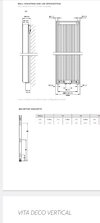Short answer... No. They're dependent upon the incoming water being warmer than what's already inside, so it rises and generally swirls about until the entire panel is hot. If you squirt hot water into the top of a cold rad with an outlet pipe on the other side then it will just shoot straight across the top and leave the rest cold. In fact this is how hot water cylinders can be set to only heat some of the contents, they rely on the hot water staying at the top and not mixing, and it works surprisingly well.
Longer answer... Yes. You can pipe from the top of the wall, drop down the back of the rad and into inlet and outlet valves at the bottom of the rad. It works well with tall rads, in which case the pipes will be invisible other than a slim bit of trunking above. This requires very careful selection of the rads, especially the spacing from the wall and low-profile pipe clips down the wall. I'm currently planning a home install and am hoping to find a plumber capable and creative enough to want to do this.
If you're interested I've mocked up a prototype using bits of wood, pipe and brackets, I can upload photos if you like. I can't see why this couldn't work, but I'm not a plumber.




